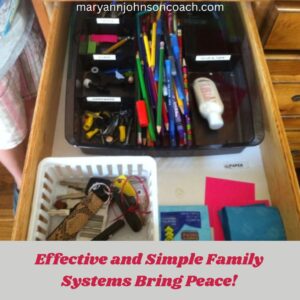 This week, as I walked with my friends Livia and Alysia, the conversation turned to their teens and the issues surrounding accomplishing things at home. At one point, Livia mentioned the need for successful systems. I told them how interesting the conversation was because I was working on my article for today, and it was about creating systems that work. Life can be so serendipitous. : )
This week, as I walked with my friends Livia and Alysia, the conversation turned to their teens and the issues surrounding accomplishing things at home. At one point, Livia mentioned the need for successful systems. I told them how interesting the conversation was because I was working on my article for today, and it was about creating systems that work. Life can be so serendipitous. : )
When I began speaking and teaching, I met a woman who became a friend and mentor, Kim Flynn. She was a systems specialist and helped me and other women find time to build businesses and successfully raise a family by using simple and workable systems. At the time, Kim had owned five successful businesses while raising her family. However, long before she began business building, she was learning to use systems successfully in her home.
I spent plenty of time in Kim’s home and with her children. I saw firsthand how well she did the very thing she taught others to do. The drawer you are looking at was in her office. She had never reordered it since it was put together, several years before, because she had a system for its management and consistently used it. It never became a junk or catch-all drawer.
You may be thinking, “That’s all well and good, but I have kids who make chaos of everything”. When I took this photo, Kim had four children, ranging in age from 2 to 11. She included them in her systems, and they learned to respect and value the freedom that systems bring. They had learned that a good system provides more time, order, and peace in a family.
I mentored mothers on parent-child connections for over fifteen years, and this one thing came up over and over again – the need for systems that worked and a family that would use them. Recently, I’ve been thinking about the value of systems. I suspect that’s because I’ve needed a couple of new ones this year.
I use systems for everything. I am a systems guru myself. I’ve been teaching my grands about systems for the last fifteen years that we have shared the same living space. It has saved me from hunting for my scissors, tape, the milk, or butter jar (yes, they get borrowed), and many other things that would engender frustration if I had to look for them all the time.
Years ago, one of the mothers I mentored asked me how I overcame my yelling habit. I wasn’t sure how to answer her at the time, but I gave it some thought. I realized I had developed a simple system. You can’t say, “I’m never going to do such and such again” and think that’s all it takes. Willpower is never enough to bring lasting change. What I did was devise a plan, a system, if you will, for what I was going to do instead of yelling. I came up with something and began using it. It wasn’t easy. It took determination and time, lots of both.
As I thought about the process I used all those years ago, I realized that the hardest part was continuing to use the system once I had figured it out. Yes, consistency was the hardest part. Years ago, I read a piece of research that showed that often, when people find a system that works to resolve a sticky situation, they soon abandon it and return to their old, unsuccessful way of managing. Interesting!
Another problem that can mess with a good system is not enrolling your family. They have no reason to keep the system going. They think it’s for your convenience and have no vested interest. Consequently, eventually there is a mess or a missing item and you must spend extra time to reorganize or find it.
During the time spent in Kim’s home, I noticed that she not only had simple and successful systems, but she had gotten her family to enroll in the systems and, for the most part, they used them successfully. I took notes and want to share them with you.
Tips to Enroll Yourself and Your Family in Simple Systems
- Ask enrolling questions
- Ask yourself and your family to participate
- Let your family know what’s in it for them
- Then earn the right to tell, teach, or request anything of them or yourself
Example One – Overcoming Procrastination, Doing The Dishes
a. Ask yourself enrolling questions. Write your response.
- How would it feel to have a clean kitchen every morning?
- Wouldn’t it feel refreshing to never feel guilty about dishes again?
b. Welcome yourself to participate. Give yourself a pep talk. Write your simple pep talk down. You can put it by your bed to read daily or tape it over the sink. : )
- This is an exciting adventure. I’m organizing the kitchen and getting the dishes done daily. I’m having a good time watching myself grow. I’m excited!
c. Let yourself know what’s in it for you. Add it to your pep talk.
- When the dishes are done and the kitchen is clean, I am free to spend time with my family. I feel happy and energized. Starting the day without dishes is wildly freeing!
d. Earn the right to ask for this change from yourself. Add this to your pep talk.
- I have done a magnificent job organizing my Sunday School class for well over two years now. I know I can organize myself and get the dishes done, just like I do with my Sunday School class.
Once you are enrolled you will have made a firmer commitment to the change. You won’t be perfect, but you’ll be successful. Whenever you find yourself flagging in your efforts, re-enroll yourself. It helps if you read your pep talk daily till you master your new system. If a system involves your family, then see the example below for enrolling them.
Example 2 – Getting Simple Chores Done Before School.
a. Ask enrolling questions.
- Would you like to be free to rest, eat a snack, or be with a friend after school?
- Can I show you how we could do that?
b. Welcome them to participate.
- I appreciate you guys talking with me this morning. I think I have a powerful idea to share with you that you’re going to love. It is going to be so freeing and restful.
c. Let them know what’s in it for them.
- The question I have been thinking about is, how we can free up more time in the afternoon to do things we want to do. When we free up time, you’ll be able to lay on the couch and enjoy a snack without having to rush. On some days, you’ll have time to watch a video or engage with your phone. Sometimes you can even have a friend over.
E. Earn the right to make this suggestion.
- I have been your mom for over 12 years, and I know a lot about getting things done really fast to make time for rest and fun. I’ve been practicing this for a long time, and I know a lot about it.
Now lay out your plan for how the chores can get done before school time. Then make sure that the rewards happen! (This will work best if you only ask for what can be done in the available time before school. For example – make the bed, put PJs away, dirty clothes in the hamper, and toys in the closet.)
The Point of This Article Is…
To encourage you to experiment with simple systems that will work for your family, systems that you can commit to and enroll your family in. The ultimate reward for this effort is saving time, reduced frustration, living with less chaos, and having more peace. When we don’t implement systems, we live by default. Our system becomes ‘no system’. This prevents a family from functioning as effectively as it could.
Look around. What’s one thing that’s bugging you? (I said ONE thing!) How could you turn it into a simple system? Now, enroll your family in the effort to make the change. They might even have some great input as to what the system could look like.
I have systems for everything – where my glasses are kept, remembering to use my c-pap, managing the dishes, getting to bed on time, managing my mother’s clothes so she knows how to find them, making sure everyone gets the right meds, at the right time, who is in charge of what, where the tape, glue, and scissors are housed, when the laundry gets done and how, garbage management, and the list goes on!

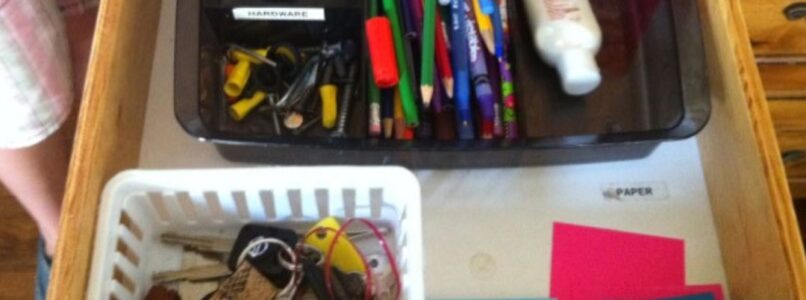
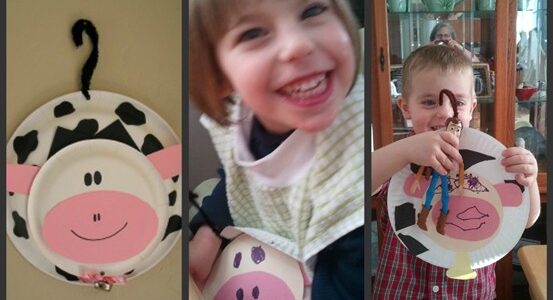
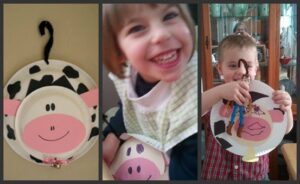 When I first began writing and publishing articles, it was in 2010. My grands, the ones I still live with, were all under five. As their grandma, I wanted to find ways to play and connect. I’m not a board game person! Tea parties and dress up are not on my list of fun things! The truth is, I like learning. I always have. I thought a lot about how I could ‘play’ with my grands and make it work for all of us. What I came up with was learning for fun. Every Tuesday, for several years, we would gather and play/learn. They looked forward to it and occasionally would tell me what they wanted to know or ask about at our next Tuesday session. It was a hit and was called Grandma School. : )
When I first began writing and publishing articles, it was in 2010. My grands, the ones I still live with, were all under five. As their grandma, I wanted to find ways to play and connect. I’m not a board game person! Tea parties and dress up are not on my list of fun things! The truth is, I like learning. I always have. I thought a lot about how I could ‘play’ with my grands and make it work for all of us. What I came up with was learning for fun. Every Tuesday, for several years, we would gather and play/learn. They looked forward to it and occasionally would tell me what they wanted to know or ask about at our next Tuesday session. It was a hit and was called Grandma School. : ) the pictures and I told them fun cow facts, such as, “Did you know a cow has four stomachs. You only have one, but a cow has four!!” That type of comment is usually followed by a question such as “Why Grandma?” Then we get to learn a bit more. Jack’s favorite cow fact was: “Daddy cows are called bulls and they go Moo really, really loud.” I did such a great daddy cow impersonation that it sent Jack into gales of laughter.
the pictures and I told them fun cow facts, such as, “Did you know a cow has four stomachs. You only have one, but a cow has four!!” That type of comment is usually followed by a question such as “Why Grandma?” Then we get to learn a bit more. Jack’s favorite cow fact was: “Daddy cows are called bulls and they go Moo really, really loud.” I did such a great daddy cow impersonation that it sent Jack into gales of laughter.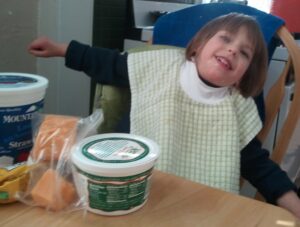 After the books, we did a cow activity. I had created a picture sheet on my computer that showed cool foods that are made from cow’s milk: cheese, cream, ice cream, milk for cereal, cottage cheese, sour cream, etc. I also had the real item on the table, if we had it. We looked at the pictures, talked about each item, and then tasted it. Of course, we all liked the cookie dough best. (It has milk in it!)
After the books, we did a cow activity. I had created a picture sheet on my computer that showed cool foods that are made from cow’s milk: cheese, cream, ice cream, milk for cereal, cottage cheese, sour cream, etc. I also had the real item on the table, if we had it. We looked at the pictures, talked about each item, and then tasted it. Of course, we all liked the cookie dough best. (It has milk in it!)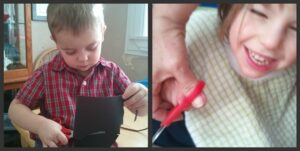 way, but then switched to using two hands and having me hold and turn the paper. Special scissors with 4 finger holes allowed me to help Maggie cut her own cow spots. She was thrilled. (Remember, Maggie, who is now eighteen, has severe cerebral palsy, so doing anything with help thrilled her and still does.)
way, but then switched to using two hands and having me hold and turn the paper. Special scissors with 4 finger holes allowed me to help Maggie cut her own cow spots. She was thrilled. (Remember, Maggie, who is now eighteen, has severe cerebral palsy, so doing anything with help thrilled her and still does.)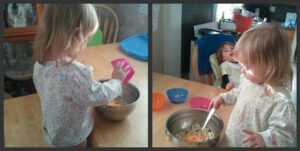 We ended the day by making mac and cheese. Cooking was a favorite activity, so everyone helped. The kids liked tasting the powdered cheese. We had our mac and cheese for lunch, and it was delicious. Maggie, Jack, and Mary decided that having cows in our world is a very good thing.
We ended the day by making mac and cheese. Cooking was a favorite activity, so everyone helped. The kids liked tasting the powdered cheese. We had our mac and cheese for lunch, and it was delicious. Maggie, Jack, and Mary decided that having cows in our world is a very good thing.
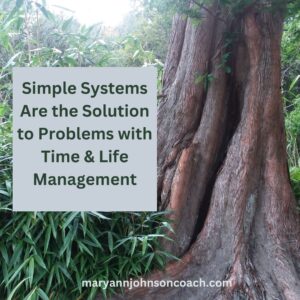 I have learned from lived experience that simple systems are usually the solution to difficult problems in time and life management. This was not an easy lesson to learn, and I occasionally still ignore this truth, but when I do,
I have learned from lived experience that simple systems are usually the solution to difficult problems in time and life management. This was not an easy lesson to learn, and I occasionally still ignore this truth, but when I do,
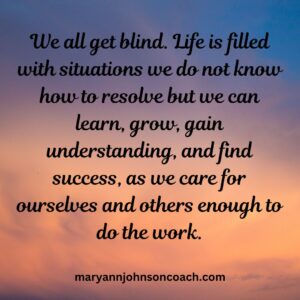 Early this spring Jodie was taking a short trip. She hauled the suitcase out of the garage so she could pack. Later, she asked me if I had seen it. No, I hadn’t but I went upstairs to help her look. We searched everywhere and then lo and behold we saw it! It was leaning up against the wall by the front door, in direct sight. It wasn’t hidden by anything. We weren’t looking for the obvious, I guess.
Early this spring Jodie was taking a short trip. She hauled the suitcase out of the garage so she could pack. Later, she asked me if I had seen it. No, I hadn’t but I went upstairs to help her look. We searched everywhere and then lo and behold we saw it! It was leaning up against the wall by the front door, in direct sight. It wasn’t hidden by anything. We weren’t looking for the obvious, I guess.
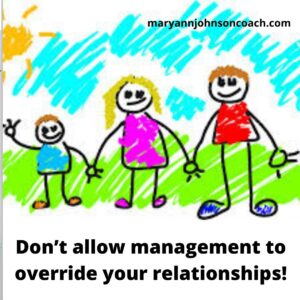 I had a funny conversation with a single dad. We were talking about how to keep things clean and how to get our kids to clean. I noticed he wasn’t an efficient housekeeper. He felt he was doing ok, and it was ok, just not very clean. : ) This comes from someone who was a professional housekeeper for almost two decades.
I had a funny conversation with a single dad. We were talking about how to keep things clean and how to get our kids to clean. I noticed he wasn’t an efficient housekeeper. He felt he was doing ok, and it was ok, just not very clean. : ) This comes from someone who was a professional housekeeper for almost two decades.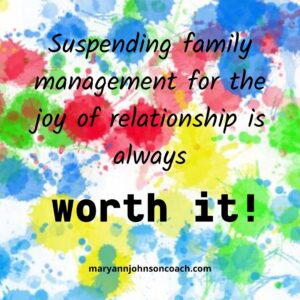

 I have the wonderful privilege of having wise and dear friends. When we can be together, we talk about the things that cause us trouble and what we are doing to ease the way. The issues the mothers we work with come up. I make notes and I share our thoughts with you. Sometimes the thoughts get buried in life for a time and then reemerge.
I have the wonderful privilege of having wise and dear friends. When we can be together, we talk about the things that cause us trouble and what we are doing to ease the way. The issues the mothers we work with come up. I make notes and I share our thoughts with you. Sometimes the thoughts get buried in life for a time and then reemerge.


 I like things my way.
I like things my way. 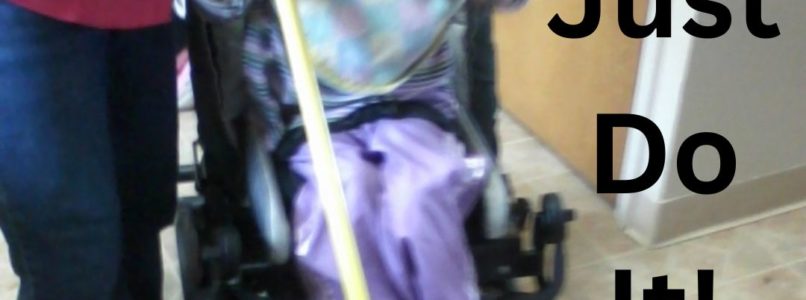
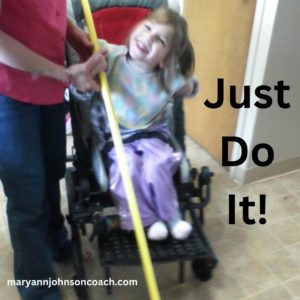 Back in 2013, when Jodie and her family moved into our three-bedroom apartment while looking for a new home, I was reminded of many things I had forgotten since my children had grown up and moved away. It takes flexibility to manage a family. Things don’t always go the way you plan, and moving forward when things aren’t just what you want, well, that is the road to feeling good as a family. Here is a peek back to that ‘learning’ time. By the way, Jodie was homeschooling Maggie and Jack and bringing Mary on board. It was a big load!
Back in 2013, when Jodie and her family moved into our three-bedroom apartment while looking for a new home, I was reminded of many things I had forgotten since my children had grown up and moved away. It takes flexibility to manage a family. Things don’t always go the way you plan, and moving forward when things aren’t just what you want, well, that is the road to feeling good as a family. Here is a peek back to that ‘learning’ time. By the way, Jodie was homeschooling Maggie and Jack and bringing Mary on board. It was a big load!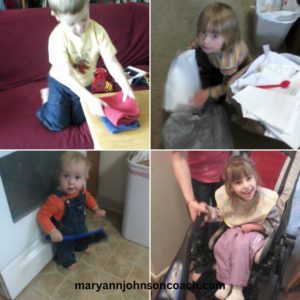 Family chores are one way that Jodie helps the children gain confidence and pride in their abilities. Jack was supposed to fold clothes. I saw Jodie pull folded dishcloths out of the drawer, unfold them, and give them to Jack to fold. (He didn’t see her unfold them.) This happened because there wasn’t any clean laundry to fold. It wasn’t that there wasn’t any laundry; it was just all still dirty. Often laundry takes a back seat to what really matters. : )
Family chores are one way that Jodie helps the children gain confidence and pride in their abilities. Jack was supposed to fold clothes. I saw Jodie pull folded dishcloths out of the drawer, unfold them, and give them to Jack to fold. (He didn’t see her unfold them.) This happened because there wasn’t any clean laundry to fold. It wasn’t that there wasn’t any laundry; it was just all still dirty. Often laundry takes a back seat to what really matters. : )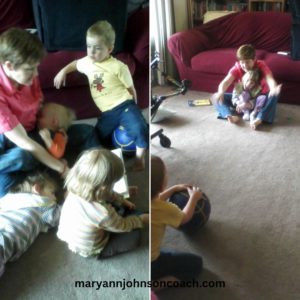 and Andy”. Then they played ball. Maggie needs help with this activity. Jack is a great big brother and did his part. Then we made hedgehogs.
and Andy”. Then they played ball. Maggie needs help with this activity. Jack is a great big brother and did his part. Then we made hedgehogs. I was so busy helping that I didn’t get a photo of the table before the project began. I would have loved for you to see it. It was a disaster. Most of what we used for dinner was still there from the night before. I am sorry to have to confess that, but there it is. Some nights we move on to something else right after the meal and often, well, we are tired. : ) Jodie did what any great mom would do. She pushed it out of the way and carried on.
I was so busy helping that I didn’t get a photo of the table before the project began. I would have loved for you to see it. It was a disaster. Most of what we used for dinner was still there from the night before. I am sorry to have to confess that, but there it is. Some nights we move on to something else right after the meal and often, well, we are tired. : ) Jodie did what any great mom would do. She pushed it out of the way and carried on.
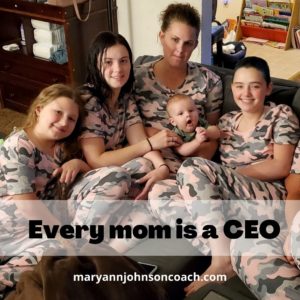 I have a friend, Nicole. She was a solopreneur, and a single mom, who homeschooled her two boys. That was a load to carry, however, Nicole manages well. That wasn’t always the case.
I have a friend, Nicole. She was a solopreneur, and a single mom, who homeschooled her two boys. That was a load to carry, however, Nicole manages well. That wasn’t always the case.